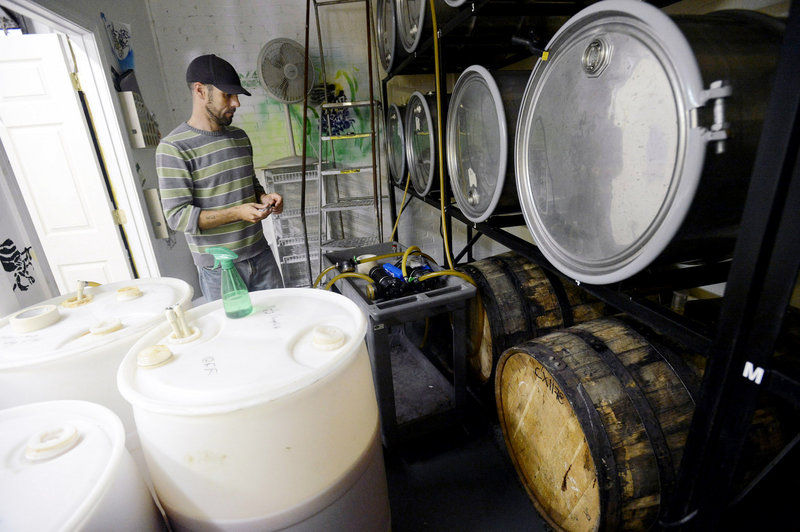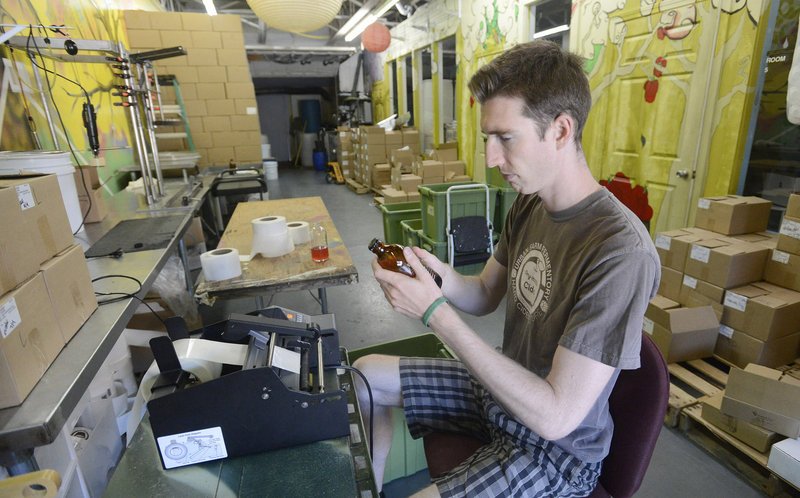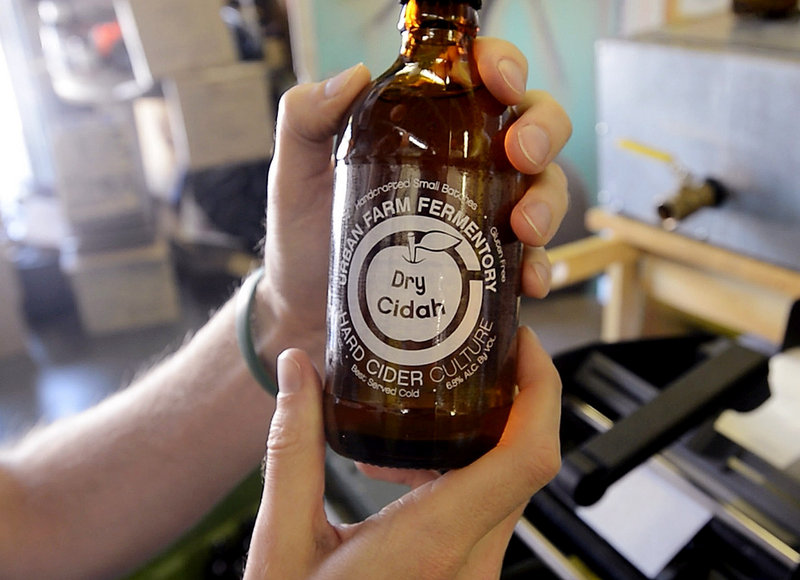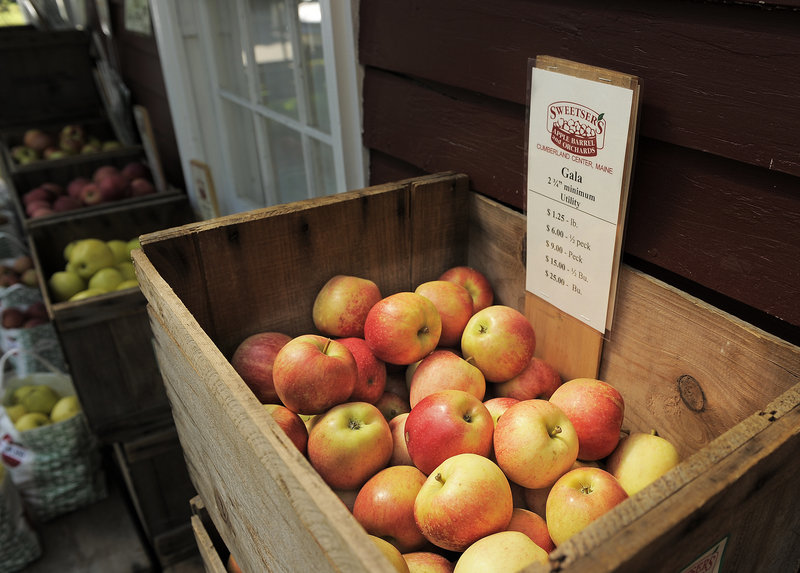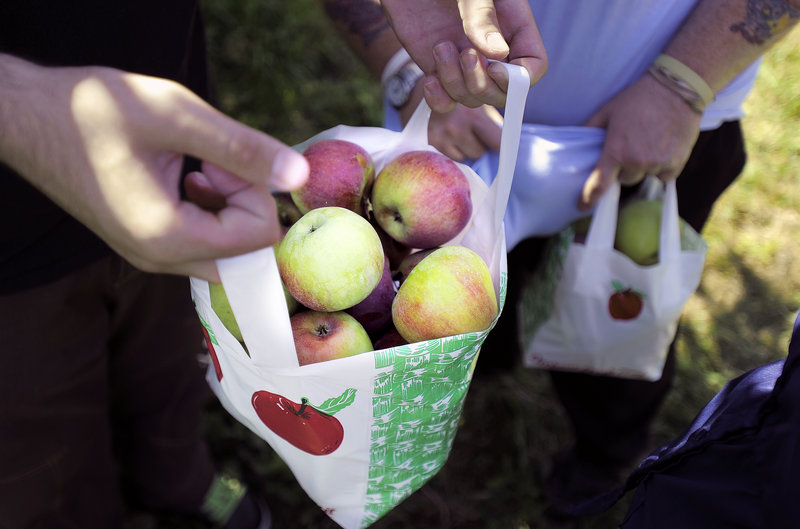Betsy Parks-Stamm is used to hearing the family stories.
Whenever she’s at an event serving the hard apple cider that she and her husband, Ben, make in Winthrop, invariably someone comes up to her and starts talking about the barrel of cider their grandfather kept in the basement.
“There’s so many mass-market alcohols,” said Parks-Stamm of Kennebec Cider. “It’s just the same in every store you go to, in every place across the country. I think cider is a way for people to connect to their local culture. Here in New England, we have this crazy history of making cider.”
Hard apple cider is a longtime New England tradition, and has a storied history in America going all the way back to the founders. Now the fizzy brew is finding new fans, thanks in part to small, local producers who are turning out a more European-style cider that’s tarter than the sweet stuff that’s usually produced in this country.
“Prohibition ruined the cider business in the United States,” said Steve Linne of Blacksmiths Winery in South Casco, who makes hard apple cider under the label Fatty Bampkins. “What happened was we converted all of our cider trees over to dessert apples, so really all we have in the U.S. for apples are dessert apples, which are sweeter.
“The Europeans obviously had no Prohibition, so they retained their cider apples, and it’s a much drier style of cider. What we’re doing here with our cider is we’re attempting to make a much drier cider, but using what’s available in Maine.”
SUDS APPEAL
Drier cider may be more appealing to beer drinkers and to men than products like Woodchuck, which are sweeter and have a reputation for appealing to women. Local cider makers also cite a number of other reasons for the resurgence of hard cider.
“I think there’s more experimental bars like Novare Res that are opening up peoples’ ideas about what things can taste like,” said Eli Cayer of Urban Farm Fermentory in Portland.
One of the biggest drivers appears to be consumer demand for a gluten-free alternative to beer. “I hear that from almost every customer,” Linne said.
One thing’s for sure: You know a product is gaining in popularity when large corporations start bellying up to the bar. Boston Beer Co., the maker of Samuel Adams beer, just introduced its “Angry Orchard” line of ciders, and Anheuser-Busch is making Michelob Ultra Light Cider.
Global Industry Analysts, a market research firm, has projected “vast growth prospects” for the global cider market and predicts revenues will reach $2.6 billion by 2015. It cited a rising demand for low-alcohol beverages and a desire among younger consumers for premium and organic products.
There are as many ways to make hard apple cider as there are reasons to drink it. Locally, cider producers are having fun experimenting with Maine apples.
“There’s a huge variety of tastes and styles,” said Nick Higgins, the cider maker at Maine Mead Works in Portland. “When you think of most apple ciders, it’s simple. It’s just cider and yeast, and maybe you’ll add a little sugar depending on how you’re doing it. Even with just those simple ingredients, you can create infinite styles, depending on the apples, different yeast strains, different ways of fermenting, different ways of aging it.”
Some craft cider makers in Maine like to tinker with their brew, others like to let Mother Nature do most of the work.
Ben and Betsy Parks-Stamm of Kennebec Cider only make their tart, semi-dry cider once a year, with fresh apples, natural carbonation and no added sugar. They pick apples from their own orchard and get more from other orchards in Kennebec County.
Adding sugar can be tricky, because more sugar translates into a higher alcohol content, and by federal law the alcohol content of hard apple cider has to stay below 7 percent or it will be considered wine.
Instead of adding sugar, the Parks-Stamms use apple varieties that are naturally higher in sugar (McIntosh, Cortland, some crab apples) and leave them on the limb for as long as possible to develop that natural sweetness. They add a champagne yeast, then ferment the apples slowly all winter at a lower temperature.
“If you ferment it really quickly, a lot of flavors and smell bubble off,” Betsy Parks-Stamm said. “If you ferment really slowly, you retain a lot of the apple flavor.”
The cider is bottled in the spring. A gallon of the cider contains about 15 pounds of apples.
At Blacksmiths, the apples come from Ricker Hill Orchards in Turner, and two fermentations are done every year, once in autumn and once in February. The fresh-pressed cider goes directly into bourbon barrels with three different strains of yeast – and Linne said he may use five strains this year. The cider ferments over four months to 7½ percent alcohol, then it’s blended back down with apple juice to 5 or 6.8 percent, depending on the product.
Steve Linne, the cider maker at Blacksmiths, has planted 38 cider trees at Ricker Hill so he’ll have more varieties to play around with in the future.
“I’m looking at eventually getting up to 18 varieties,” he said. “Each time you add an apple variety or a yeast variety, you can think of it as a note. A single note’s not very interesting. But you put them all together, and you get a song.”
CONSISTENCY IS KEY
That makes cider making sound like an art, and it could perhaps lead to some interesting new styles of cider. But when it comes to individual products, Linne says consistency is important. “The American consumer does not accept inconsistency,” he said.
One reason Linne ferments for four months is that sediments settle in the barrel so that the cider comes out consistently clean, not cloudy. Consumers will drink cloudy beer, he said, but not cloudy wine, and cider is right in between.
The issue of consistency is where you’ll also find varying opinions within the Maine cider-making community.
Eli Cayer, who produces three styles of cider (Dry Cidah, Dry Hopped Cidah and Baby Jimmy) at Urban Farm Fermentory, is never quite sure how the next batch will taste. He gets his apples from a couple of cider mills, primarily Giles Orchard in Alfred, accepting whatever varieties they happen to be selling at the time. On a recent visit to his fermentory on Anderson Street, he had two barrels of McIntosh and two barrels of Paula Red and Ginger Gold.
“Our approach,” he said, “is very primitive, and very simple: Get juice. Let it ferment. Period.”
Cayer wild ferments everything, which means the apples are fermented with whatever naturally-occurring yeast is on them. The exception is an experimental batch he’s working on now that is being fermented with a Japanese sake yeast. He plans to market that cider to local Japanese restaurants.
Cayer’s unfiltered cider comes in at about 6.5 to 6.8 percent alcohol, and it’s fairly dry.
“It’s always a little different,” he said. “We embrace that. I had a batch that (tasted) more like rhubarb, almost. It was really interesting. It was delicious, and I could go back and find out what apples it was, but there’s so many variables with wild yeast and everything, it’s almost impossible to replicate exactly what we’re doing.”
Ben Alexander, the owner of Maine Mead Works, decided to jump into the cider market last spring. He estimates his company’s first cider will be available in growlers the first week in October. He’s already planning on adding more fermentation tanks.
“There seems to be a growing demand for local cider,” he said, “so back in May when we were planning to do this, we thought this would be enough. Now it’s looking like we may be doubling” capacity.
Maine Mead Works cider maker Nick Higgins said the turnaround time for their cider is about three weeks – a couple weeks of fermentation, plus a week to filter. They use forced carbonation to give it a fizz.
Maine Mead Works also sources its cider from Ricker Hill Orchards. It’s made predominantly from McIntosh apples, but also some Cortland, Macoun and Red Delicious.
“We really wanted to come out with something that was simple, light, straightforward,” Higgins said. “(We wanted to) showcase the apple flavor without too much sweetness, so you get the essence of the apple without being overwhelmed by too much sugar.”
The Maine Mead Works cider is fermented in jacketed tanks filled with coolant that controls the temperature during fermentation, leaving it around the low 60s, “which gives us a light, crisp, clean flavor,” Higgins said.
No sugar is added, but they do add a yeast strain. The alcohol content of the finished product is low, about 4.5 to 5 percent.
“Each yeast strain is going to provide a different flavor profile, even if you start with the exact same apples,” Higgins said. “Between yeast and the temperature, and sourcing (the apples) from the same source, that’s how we control consistency.”
The Maine Mead Works cider is the house cider at Gritty’s, and Alexander and Higgins said they hope to sell growlers out of the tasting room on Washington Avenue soon.
“There’s been a lot of demand for that,” Alexander said.
Staff Writer Meredith Goad can be contacted at 791-6332 or at: mgoad@pressherald.com
Twitter: MeredithGoad
Send questions/comments to the editors.


